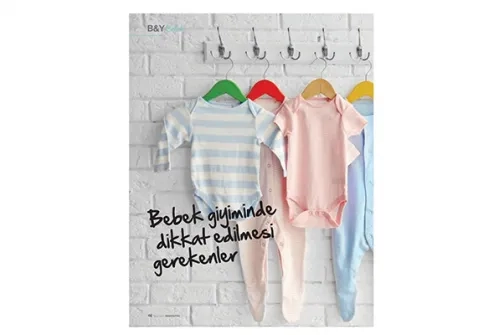Alo Yeditepe
Alo Yeditepe
Points to Be Considered in Baby Clothing
The Pediatrician in Bagdat Street Policlinic of Yeditepe University explained what to consider when choosing clothes for babies.
Baby clothes must be 100% cotton. Synthetic products should never be preferred. Especially breathable fabrics are healthy for baby's skin.
Baby clothes should be soft and flexible and should not irritate the baby's skin. Furry and woolen clothes should not be preferred as they can trigger allergies.
Clothing should be loose enough for babies to move freely in. Clothes should be bought according to the baby's weight, not the baby's age.
The seams and neck should not irritate the skin. It should not contain accessories such as buttons that the babies can remove and put in their mouths.
Socks should not be too tight and there should be no threads or laces in them, as they can get tangled in the toes and disrupt circulation.
You Should Check Its Accessories
Non-synthetic fabrics obtained from natural products such as cotton, wool, and bamboo should be preferred in baby clothes. It should not be adorned with small parts such as buttons and beads that can easily be pulled off by the baby's hand or mouth and swallowed while using it. The sucking instinct in babies is a very strong reflex and the corners of the clothes, laces, buttons and all kinds of details attached to the clothes are ideal for sucking. However, these tiny pieces break off easily and are swallowed. The swallowed parts sometimes get into the stomach and sometimes into the lungs and cause unpleasant consequences that harm the baby. The dye of the fabric should not be carcinogenic and should not fade and flow easily when washed. Eczema, which is frequently seen in babies, is caused by chemical substances in the fabric that comes into contact with their skin, and rubbery substances such as latex in the fabric texture. In addition, these ingested dyes that get into the mouth while sucking the fabric may cause toxic results. Pay attention to other textile products too! Blankets made of cotton yarns, which are suitable for baby skin, soft, lint-free, and not rough, can be preferred. Bed linen should be made of cotton fabrics that can be washed frequently and dyed with single-color or non-fading dyes.
Choose Cleaning Products Carefully
Baby products should be washed with cleaning products that are easy to rinse and that do not leave any detergent residue on the fabric when rinsed. It is not recommended to use fabric softener and bleach. I recommend double rinsing after washing and removing detergent residues from the skin. Products that can be ironed should be ironed. Laundry can be stored in moisture-free environments. Laundry comes into direct contact with the skin of babies and children, and when there are chemicals, detergent residues, and dyes in it, they cause damage to the tissue on the skin surface forming a barrier to the skin. Chemicals, dust, microbes, and allergens easily pass from the skin to the body through the pores of the skin whose barrier structure is deteriorated, and the water in the body leaks out from the skin. As a result, the skin dries up and after a while, it turns into itching, redness, and what we call dermatitis (eczema). We now know that eczema is a starting point for allergic diseases. In addition, clothes are related to diseases that are not atopic, but only caused by contact, which we call contact dermatitis. Can babies wear printed products? It would be more accurate to say that I prefer them not to be worn rather than saying that they cannot be worn for sure. If the print is not made of good quality, it can easily separate from the fabric, crumble and fall off. This may damage and irritate the baby's skin, and pieces falling off from the printing may be swallowed. Patterned fabrics should be preferred instead of printing. Eczema is a starting point for allergic diseases. In addition, clothes are related to diseases that are not atopic, but only caused by contact, which we call contact dermatitis.
Can Babies Wear Printed Clothes?
It would be more accurate to say that I prefer them not to be worn rather than saying that they cannot be worn for sure. If the print is not made of good quality, it can easily separate from the fabric, crumble and fall off.
This may damage and irritate the baby's skin, and pieces falling off from the printing may be swallowed. Patterned fabrics should be preferred instead of printing.
About
Faculty and Year of Graduation:
Hacettepe University Faculty of Medicine, 2000
”
See Also
- Is Swallowing Cat Hair Dangerous?
- What is Predisposition to Allergy (Atopy)?
- Allergies in Children Can Increase During the Summer Months
- How to Choose Baby Clothes?
- If Your Child is Constantly Getting Sick in the Winter, It Could be Due to Allergies
- Vaccine Rejection Can Lead to Irreversible Problems!
- Children Whose Parents Are Allergic Are More At Risk
- Pay Attention to the Children Who Get Sick Often
- Allergic Disease Rates Increased from 3% to 15% in the Last 20 Years
- High Fever in Children Article Series I
- Genetics is the Key Cause of Food Allergies in Children
- Pay Attention to Food Allergies in Children!
- What and How Much Should Children Eat at Which Time of Meal?
- What is the Right Lunch Box for Children?
- Infection Can Cause the Onset of Asthma Disease
Alo Yeditepe











